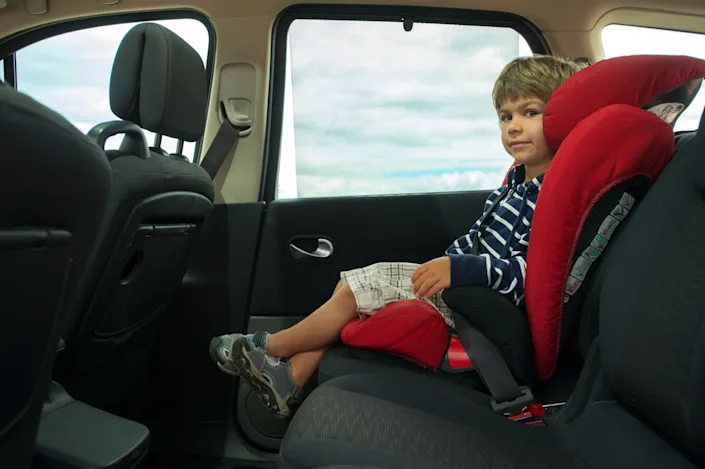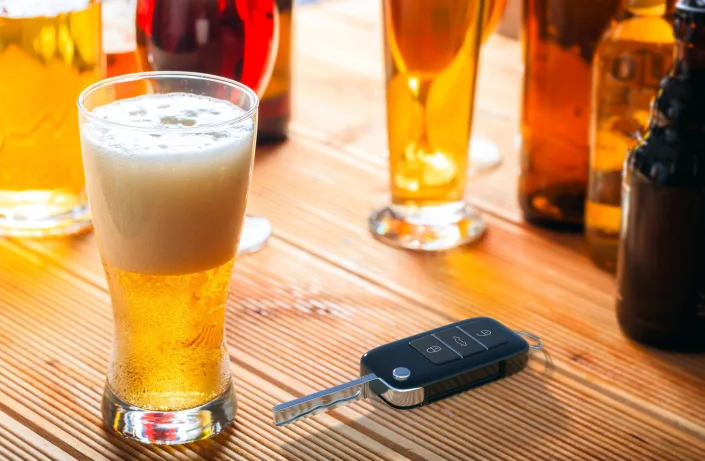
One of the most important ways parents can keep their children safe is by properly using child safety seats in the car. According to the National Highway Traffic Safety Administration, the leading cause of child deaths is motor vehicle accidents. Not only should children sit in car seats that are appropriate for their age and weight, but they must be properly secured in those seats.
With hundreds of options to choose from, parents often ask which child restraints they should use in their cars. The right type of seat – from a harness seat to a high-back booster – depends on the child’s weight, height and age. In addition, each state has its own set of laws and practices for mandatory seat use.
When should an infant sit in a rear-facing car seat? When is it appropriate for a child to transition to a booster seat? Yahoo Life spoke with car seat safety experts to get more information on the best ways for parents to ensure their children are safe in the car.
What is a car seat?
A car seat is the seat a child sits in while riding in a vehicle that uses a five-point harness system as a means of restraint. This system ensures that small children are properly positioned in the event of an accident. There are forward-facing and rear-facing options, with many states requiring young children to sit in rear-facing car seats. Forward-facing seats are most commonly used for toddlers and preschoolers, and most seats are capable of accommodating children up to 60 pounds.
What is the appropriate age for a car seat?
Rear-facing car seats are most appropriate for newborns, infants and toddlers, and in some states, are mandatory by law. The type of seat used also depends on the type of vehicle you own. Car seats are most commonly used for children under 5 years of age weighing 40 pounds.
How to ensure proper car seat installation
Car seats can be installed using the vehicle’s seat belt or the LATCH (Lower Anchor and Tether for Children) system. The LATCH system is designed to help parents easily and correctly install the seat without the use of a seat belt. Once installed, parents are advised to have their car seat checked by a child passenger safety technician prior to use. Registering the car seat with the manufacturer will also keep mom and dad informed of any parts issues or recalls. Once installed, the harness should fit snugly over the child’s shoulders with the clip located in the center of the chest. Thick clothing, such as winter coats, are discouraged because they can compress in a crash, leaving too much space between the child and the restraint.
What is a booster seat?
A booster seat is a seat in which a child sits and which uses the vehicle’s seat belt as a means of restraint. High-back booster seats provide head and neck support for vehicles without head restraints. Some seats can be transitioned from a car seat to a booster seat, but the difference between the two is important.
What is the appropriate age for a booster seat?
If the five-point harness is working properly, do not rush to transfer your child to a booster seat. For booster seats, children should be at least 5 years old and 40 pounds, laws vary by state. For booster seats, the vehicle’s seat belt needs to be properly adjusted over the child. A booster seat is required until the child is large and tall enough to be secured with the vehicle’s seat belt. Transitioning to using only the vehicle’s seat belt depends on each child, but this usually occurs between the ages of 10 and 12.
Correct positioning is critical
Not all booster seats need to be secured, but this depends a lot on the style of the car and seat. The purpose of a booster seat is to ensure that the vehicle’s seat belt properly restrains the child and fits snugly over their hip bones, not their abdomen. The boost provided by the seat also ensures that the shoulder portion of the harness goes through the middle of the child’s chest and shoulders and away from the neck.
How can parents determine when it’s safe to move their child from the car to the booster seat?
Cass Herring is a Certified Technical Advisor for Child Passenger Safety with Safe Kids Worldwide, an organization dedicated to protecting children from unintentional and accidental injuries. Once a child outgrows a forward-facing seat with a seat belt and meets the minimum height, weight and age (if specified) requirements for a booster seat, a fit test can be conducted to determine if the child is ready for a booster seat. Herring told Yahoo Life. “To determine if the booster fits, caregivers should look to see that when the harness is properly arranged and buckled, the harness is lower at the knee and across the hips rather than the abdomen, the straps are across the chest and shoulder contact, and the child is able to maintain proper posture throughout the ride.”
Finally, Herring believes it is absolutely critical to follow state laws and car seat manufacturers’ age, height and weight guidelines.
When is a child ready to safely ride in a vehicle without a booster seat?
“When the seat belt fits them, the child can transition to using a seat belt without a booster,” Herring explains. “For testing purposes, the child should be able to [check certain safety issue boxes] and stay in place for the entire ride.”
If the answer to one of these safety questions is “no,” Herring says, the child is not ready for the booster.
Can they lean their backs on the seat without becoming lethargic?
Do their knees bend naturally in the seat?
Can they put their feet flat on the floor?
Does the lap belt fit snugly around the upper thighs and under the hips?
Does the seat belt go across the chest and not across the face or neck?
Explaining to older children why they still need to use a booster seat can be a challenge. “Children are very curious, and it can be helpful to discuss the benefits of a booster seat with them,” shares Herring. “A great suggestion is to show them how the booster seat lifts them up and gives them a better view out the window.”
“Get the kids involved in the process,” she added. “Let them pick out the colors or features they might want on the booster.”
For Jenny Cruz, the mother of a 6-year-old, the transition from car seat to booster went smoothly. “I wasn’t nervous, she’s tall and the larger car seat was uncomfortable for her,” Cruz said. “She was always nice to be strapped into the seat instead of trying to get out of it.”
Cruz said she switched seats with her daughter around age 5. “The booster seat made it easier for her to sit and she was more comfortable: We talked about the seat belt and why it was there for safety reasons, so she did well.”
Tarah Chieffi, a mother of three, says her children are tall, so once she knew it was safe, she was eager to make the change so they would feel more comfortable in the car. “I wasn’t worried about whether they were big enough to transition,” she says. “I base it on their height and age.”
For her first two children, Chieffi says she waited until they were 4 years old to make the change. “Only our youngest remained in the five-point harness car seat, and after successfully switching our two older children to booster seats, it felt easier to make the decision for our third child,” she says. “You’re always more worried about your first child because you haven’t experienced it before, but once you have some experience, it gets easier.”
State Car Seat Laws.
Alabama: Alabama’s car seat law requires that children between the ages of 1 and 15 be restrained in some way. Newborns and infants under the age of 1 must sit in a rear-facing position in a convertible seat, while children ages 1 to 5 can sit in a forward-facing seat. Car seat age requirements for children 5 and 6 years old are retrained in booster seats, but any child over 6 years old may only be restrained in a seat belt.
Alaska: Children 8 and under must sit in a booster if the car seat is oversized, but children under 8 may ride without a booster if they are properly buckled in without a booster.
Arizona: Arizona’s car seat law requires all children under the age of 8 and under 4 feet 9 inches tall to use some type of child restraint system in a moving vehicle. Children under the age of 5 must be in a convertible car seat or other type of safety restraint regardless of height.
Arkansas: Children must be seated in an age-appropriate seat until they reach 60 pounds.
California: California child car seat safety laws take into account the height and weight of the child when determining the appropriate seat. Children should remain in a child restraint for as long as possible or until the age of 12 or 13.
Colorado: Children from birth to age 15 must use some type of safety restraint when traveling on the highway.
Connecticut: Connecticut child car seat laws require children and adolescents to be buckled into an appropriate child restraint based on their age, weight and height. However, the law only considers car or booster seat weight and age limits for child restraints.
Delaware: Delaware requires children to use a child restraint while riding in a vehicle until the age of 8. However, children under 8 years of age in booster seats weighing more than 64 pounds may only wear a seat belt.
Florida: Florida requires anyone operating a motor vehicle with a child passenger under the age of 6 to secure them in a federally approved child restraint. Their weight is not relevant to this requirement.
Georgia: Georgia’s car seat law requires that all children under the age of 8 and under 57 inches tall cannot sit in the front of a vehicle because of the health risks posed by airbags. Any child under the age of 8 can use a car seat or booster when appropriate.
Hawaii: Hawaii car seat laws require all children under the age of 4 to be in a car seat when riding in any vehicle. Children between the ages of 4 and 7 may ride in a car seat or booster seat in any vehicle.
Idaho: Idaho requires the use of any appropriate restraint for children under the age of 7.
Illinois: Illinois car seat laws require all drivers transporting children under the age of 8 to properly restrain those children. This may mean using a car seat or booster seat depending on the age, weight and height of the child.
Indiana: Indiana car seat laws require the use of child car seats or booster seats for all children under the age of 8.
Iowa: Iowa’s child car seat law requires all children from birth to age 1 to use a rear-facing child restraint system. The child must also weigh at least 20 pounds to switch to a forward-facing system. Car seat laws include the use of child restraint systems for any child under the age of 6.
Kansas: Kansas requires drivers transporting child passengers to comply with child restraint rules based on age, weight and height.
Kentucky: The Kentucky car seat law requires the use of a child restraint system for any child 40 inches or less in height. The car seat safety rules require that any child under 8 years of age and between 40 and 57 inches tall must be in a child booster seat. However, any child over 57 inches tall does not need a booster, regardless of age.
Louisiana: Louisiana requires all children under the age of 6 or weighing 60 pounds or less to be restrained in a child restraint system, which may include a car seat or booster seat. The booster seat weight requirement will end for any child who is at least 6 years old or weighs more than 60 pounds.
Maine: Maine’s car seat safety law requires that all children weighing less than 40 pounds be equipped with a child car seat. All children between 40 and 79 pounds and under the age of 8 must use a federally approved car seat or child booster seat.
Maryland: Maryland requires all children under the age of 8 to use a child restraint system based on the child’s weight and height.
Massachusetts: In Massachusetts, child passengers must be secured in an approved booster seat or restraint until they are at least 8 years old or 57 inches tall.
Michigan: Michigan’s child safety seat law requires children 4 years of age and younger to be seated in a car seat in the rear of the vehicle. Children 8 years of age or at least 4 feet 9 inches tall must be properly buckled into a booster seat or car seat.
Minnesota: Minnesota requires all children under the age of 8 to ride in a federally approved car seat or booster seat unless the child is at least 4 feet 9 inches tall.
Mississippi: The Mississippi Department of Health has issued recommendations on the type of seat children should use based on their age.
Missouri: Missouri requires that all children under the age of 4 be secured in an approved car seat and that all children under the age of 16 be properly secured in the vehicle.
Montana: Montana’s booster seat law requires that children under the age of 8 weighing less than 60 pounds be restrained in an appropriate child safety seat in a motor vehicle.
Nebraska: Nebraska requires all children under the age of 8 to be in a federally approved child safety seat.
Nevada: Nevada’s car seat law requires that any child under the age of 6 and weighing less than 60 pounds must be protected in a federally approved child safety system.
New Hampshire: New Hampshire guidelines state that any child under the age of 6 must be protected by a federally approved child restraint.
New Jersey: New Jersey law requires that every child under the age of 8 or under 57 inches tall in a vehicle in which the child is riding as a passenger must be secured in the back seat of the vehicle.
New Mexico: New Mexico law requires all children, regardless of size, to ride in a properly sized car seat or booster seat until their seventh birthday. Every child, regardless of age, must use a car seat until they weigh at least 60 pounds.
New York: New York car seat laws specify the age or size a child must be to begin using an adult seat belt. All safety seats and booster seats must meet federal vehicle safety standards.
North Carolina: North Carolina’s car seat law applies to all children in the state who are under 16 years of age or weigh less than 80 pounds.
North Dakota: North Dakota car seat requirements vary depending on the height and weight of the child and the product manufacturer’s recommendations.
Ohio: Ohio law requires all child passengers to be in a properly sized safety seat or booster seat until they meet the minimum height requirement or turn 8 years old.
Oklahoma: Drivers must comply with Oklahoma’s car seat law when operating a motor vehicle with a child passenger under the age of 8 or less than 4 feet 9 inches tall.
Oregon: Oregon law requires all child passengers to use an appropriately sized safety seat when riding in a motor vehicle. Once a child exceeds the age or height requirements for the car and booster seat, they may use an adult seat belt.
Pennsylvania: Pennsylvania requires all children to use an acceptable type of child restraint when riding in a vehicle until the age of 8.
Rhode Island: Rhode Island car seat laws require the use of a car seat or booster seat if the child is less than 8 years old, less than 57 inches tall and weighs less than 80 pounds.
South Carolina: South Carolina requires the use of a car seat for child passengers under the age of 8. Children at least 57 inches tall or 8 years old may use an adult seat belt provided the lap belt fits snugly around the thighs and hips and the shoulder belt rests against the chest.
South Dakota: South Dakota requires all children under the age of 5 and weighing less than 40 pounds to use an approved safety seat. In most cases, once a child reaches 4 feet 9 inches in height, they can wear an adult seat belt.
Tennessee: Tennessee car seat laws require all young passengers to use a properly installed child restraint system while riding in a motor vehicle. In most cases, the restraint system consists of a child car seat or booster seat.
Texas: Texas law requires the use of a car seat or booster seat for all children under 8 years of age or less than 4 feet 9 inches tall. Once children reach 4 feet 9 inches in height, they may use adult seat belts while riding in a motor vehicle.
Utah: Utah’s car seat law applies to all child passengers under the age of 8 and under 57 inches in height.
Vermont: Most car seat laws in Vermont are based on the weight, height or age of the child. Children between the ages of 8 and 15 may wear an adult seat belt with or without a booster seat, as appropriate.
Virginia: Virginia’s car seat regulations are based on the child’s age, not weight. Age-appropriate child restraints are required for all children until their 8th birthday.
Washington: Washington State requires all children to use an age-appropriate car seat until they are 8 years old or 4 feet 9 inches tall.
Washington, DC: Washington, DC requires all drivers to use a child restraint seat when transporting children under the age of 3. Children under the age of 8 must use an age-appropriate car seat, toddler seat or booster seat that uses a lap and shoulder belt.
West Virginia: Under West Virginia law, all children under the age of 8 must ride in an age-appropriate car seat or booster seat.
Wisconsin: Wisconsin car seat law requires that all children under 8 years of age or less than 4 feet 9 inches tall must ride in a seat appropriate for their size.
Wyoming: Wyoming law requires all children to be in an age-appropriate safety seat until their 9th birthday.



